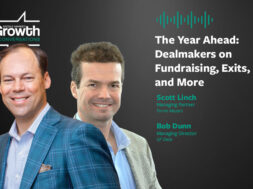Plant Genetics Businesses, Ripe for Innovation, Pick Their M&A Partners
Cross breeding and molecular breeding companies are tackling climate change, hunger and crop resilience. Experts say choosing a patient investor is vital to fueling innovation.

This summer, when you bite into that juicy seedless watermelon or an extra-sweet peach, you’ll largely have innovations plant genetics to thank.
The practice of cross-breeding crops has ancient roots, and today the plant genetics market, which now includes molecular breeding and genetic engineering, is big business: IMARC analysis expects a CAGR of the plant genomics market to hit more than 6% through 2033, with a forecasted market value of $18.49 billion.
“Genetics play a critical role in helping not only to feed a hungry planet in the years ahead, but also to help growers and fruit marketing companies differentiate themselves and have more sustainability as a business, and to be more environmentally sensitive and responsible,” says David Marguleas, executive chair of Sun World International, a fruit variety development and licensing company (which commercialized the seedless watermelon in 1988).
Join us for the 2025 ACG Ag Conference: Field to Processor
Join ACG on October 6-7 for the 2025 Ag Conference, a two-day event in St. Louis that will explore opportunities across the agriculture supply chain, from field to processor. Attendees will leave the Ag Conference with a deeper understanding of investment opportunities within agriculture, along with new business connections and sources of deal flow.
As emerging advancements in plant genetics buck the agriculture industry’s reputation for being slow to modernize, the opportunity for M&A to support innovation has grown. Experts note, however, that it takes a particular kind of investor to drive progress.
Ripe for Innovation
Fruits, vegetables and grains have been cross bred for millennia for a variety of purposes, including introducing new varieties of a crop that are tastier, more resilient or offer a larger yield.
Today, there are a variety of modern incentives for plant genetics innovation. Contemporary pressures on the agriculture industry include climate change, pest control, supply chain friction that threatens product quality while in transit, and population growth and hunger crises that require larger crop volumes. Technological innovation has opened the door for businesses in the space to meet these challenges in a variety of ways.
Cross breeding and molecular breeding are a promising avenue to addressing these issues. Sun World launched its own breeding program 30 years ago alongside its traditional produce operations, which were eventually spun off to focus solely on the development of new fruit genetics.
While cross breeding involves physically mating two plants to yield desirable traits, molecular breeding uses DNA tools to identify and turn on or off genetic traits, a process Marguleas describes as “an incredible efficiency tool” that “brings a lot of precision to the otherwise random process of conventional breeding.”
As the science behind these practices evolves, tech innovators in the SaaS and AI spaces have also stepped in to support the plant genetics space.
They include companies like Canada-based Agronomix Software, which offers plant breeders and crop researchers software for crop yield increases, seed inventory and broader data analysis.
“If you think of the entire supply chain within the ag industry, we’re right at the beginning,” says Agronomix President Chris Leonard. “Our users are creating new varieties and hybrids of crops to work better in different climates, or in new or changing climates.”
Agriculture may have a reputation for lagging in tech adoption, but Leonard refutes that assumption. “I think of all of the technology that’s involved in planting and harvesting—these big hardware devices pretty much all have some software component now,” he says. “Whether its GPS, the advancement of spraying with drones and knitting pictures together and analyzing them—we still have a long way to go, but I don’t think we’re as far behind as people think.”
Both Agronomix and Sun World are exploring the opportunities in tech like AI. For Sun World, AI-powered predictive analytics can use historic crop and breeding activity data to inform strategy moving forward. “If you take two parents of a table grape variety, and use that data collected over the previous 10 years on how those two varieties performed in the field, you can use that to predict what a successful cross might look like going forward,” says Marguleas, adding that these technologies greatly enhance efficiency and accelerate time-to-market.
Peas in a Pod
Leonard is bullish on AI adoption, too, though acknowledges that progress in tech adoption within the plant genetics space requires patience thanks to the time it takes to not only develop a new solution, but test it out with plants that take several growing seasons to assess performance.
Understanding the long-term nature of this industry is vital to choosing the right M&A partner, says Leonard. In 2022, the company was acquired by agriculture-focused software company Cultura Technologies, a division of software conglomerate Volaris Group. “The culture of Volaris is buy and never sell. That’s their philosophy,” says Leonard. “It’s one of the driving forces that made us stick with them through the years.”
Marguleas agrees that patience is valuable in this market, and acknowledges that shorter-term investors’ business models may find the plant genetics industry a bit more challenging. But for those that understand the space, its long-term nature can actually be a benefit.
“From an investor’s standpoint, there is a degree of reliability and predictability to our business that one doesn’t find in many industries,” says Marguleas. “The fact that we’re developing crops that have a 20, 25-year lifetime in the form of trees and vines that get planted, and the recurring revenue of the proprietary genetics industry, those (factors) are certainly appealing to the investor community, whether it’s a private equity group, a family office, a venture capital firm or a strategic that’s interested in the opportunities that proprietary varieties bring to their business.”
Sun World is backed by private equity firm Bridgepoint, which acquired the company in 2021. Bridgepoint became a particularly impactful partner for the company, says Marguleas, not only because the firm was familiar with the industry’s sometimes lengthy product development timeframes, but because the sponsor offered Sun World access to innovation from other agriculture companies in its portfolio—a “huge value-add,” he says.
Last year the business finalized its own acquisition of South Africa-based Biogold, a deal that Marguleas says was a significant growth opportunity for the company that allowed it to meet more needs in an overlapping customer base. Biogold manages plant breeders rights and specializes in citrus, mango and avocados, complementing Sun World’s existing footprint with table grapes, plums and stone fruits.
That benefit of collective knowledge highlights what both Marguleas and Leonard say is another important component to choosing the right M&A partner, whether that be a buyer or seller.
Leonard acknowledges that M&A may have a reputation for slowing down innovation, but in plant genetics and agtech overall, a collaborative sponsor with access to financial resources and valuable IP across its portfolio can greatly accelerate innovation.
“Innovating is a little different (post-acquisition),” he says. “You have to pivot a little bit, and there is a bit more justification you have to make…But that doesn’t mean innovation has to die, it just means business leaders have to be more prepared to justify it.” For an accelerated product development cycle, Agronomix has implemented a five-week test period for new innovations before bringing new solutions up the chain of command, which Leonard describes as a “fail fast” strategy.
“We need to demonstrate to smaller organizations that they can sell, and if they do, they’re not going to get replaced. Their company is not going to get absorbed or dissolved,” says Leonard. “They’re going to be given the tools they need to go up to the next level to become a bigger organization. The conversations that I have with M&A often revolve around those comments: we are better together. We have real industry problems that we can solve if we work together.”
Carolyn Vallejo is ACG’s Senior Editor.
Middle Market Growth is produced by the Association for Corporate Growth. To learn more about the organization and how to become a member, visit www.acg.org.


